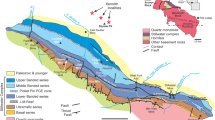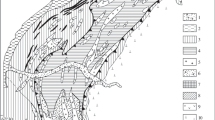Summary
The Kullen-type sills of western Dronning Maud land are up to 400 m thick and form part of the Meso- to Neoproterozoic Borgmassivet suite. They consist of a Basal, Cumulate, Central and Upper zone. The petrography of the Cumulate zone, with special emphasis on the occurrences at Hammer Heads in the Annandagstoppane area, is described. Microstructures, such as delicate chains of orthopyroxene primocrysts and an increase in grain size of plagioclase chadacrysts from the cores to the margins of postcumulus clinopyroxene oikocrysts, indicatein situ crystallization. Composite grains with orthopyroxene at the core, which is mantled, in turn, by inverted pigeonite, a second generation orthopyroxene and, on the outer margin, clinopyroxene in a reaction relation with the orthopyroxene, are sporadically developed.
The relation between the composite structures and plagioclase nucleation and growth is investigated by the study of plagioclase grain size distributions, nucleation density and An compositions of plagioclase cores, which indicate that two periods of plagioclase nucleation occurred. The first period of nucleation, represented by plagioclase chadacrysts enclosed in primocrysts of orthopyroxene, occurred during supercooling following intrusion. Release of latent heat of crystallization resulted in an increase in magma temperature and a normal sequence of fractional crystallization in which orthopyroxene crystallization was succeeded by pigeonite. The second period of plagioclase nucleation depleted the interface liquid in the zone of crystallization of calcium. The composition of the interface liquid was thus changed from the compositional field from which pigeonite crystallized to that from which orthopyroxene crystallized (cf the liquidus boundaries in the system CaMgSi2O6-Mg2SiO4SiO2 ofKushiro, 1972). This constitutional supercooling (Chalmers, 1964;Tiller, 1991) resulted in crystallization of orthopyroxene and the reverse crystallization sequence En-rich orthopyroxene -pigeonite - En-rich orthopyroxene, prior to reaction of the last-formed orthopyroxene with the liquid to form clinopyroxene and subsequent inversion of pigeonite. A possible crystallization sequence is discussed by making use of thespeculative Fo-Di-An-SiO2 (forsterite-diopside-anorthite-silica) system ofMorse (1980).
Zusammenfassung
Lagergänge des Kullen-Types im westlichen Dronning Maud Land sind bis zu 400m mächtig und sind Teil der meso- bis neoproterozoischen Borgmassivet-Abfolge. Sie bestehen aus einer basalen, einer Cumulat, einer zentralen und einer oberen Zone. Die Petrographie der Cumulat-Zone wird mit besonderer Betonung der Vorkommen von Hammer Heads im Annandagstoppane-Gebiet beschrieben. Mikrostrukturen, wie z.B. feinkörnige Ketten von Orthopyroxen-Primokristen und eine Zunahme in der Korngröße von Plagioklas-Chadakristen von den Kernen zu den Rändern in postcumulus Klinopyroxen-Oikokristen, weisen aufin situ Kristallisation hin. Zusammengesetzte Körner mit Orthopyroxen im Kern, der von invertiertem Pigeonit umgeben ist, einer zweiten Generation Orthopyroxen, und, am äußeren Rand, Klinopyroxen in Reaktionsbeziehung mit Orthopyroxen, kommen sporadisch vor.
Die Beziehung zwischen diesen zusammengesetzten Strukturen und der Nukleation, sowie dem Wachstum von Plagioklas wurde durch das Studium der Plagioklaskorngrößen, der Nukleationsdichte und der An-Zusammensetzung von Plagioklas-Kernen untersucht. Diese weisen darauf hin, daß zwei Perioden von Plagioklas-Nukleation vorgekommen sind. Die erste Nukleationsperiode wird durch Plagioklas-Chadakristen, die in Primokristen von Orthopyroxen eingeschlossen sind repräsentiert, und fand während einer Phase von Supercooling im Anschluß an die Intrusion statt. Das Freiwerden latenter Kristallisationswärme führte zu einer Zunahme der Magmentemperatur und zu einer normalen Abfolge fraktionierter Kristallisation, in der auf die Orthopyroxen-Kristallisation Pigeonit folgte. Die zweite Phase der Plagioklasnukleation führte zu einer Verarmung der Schmelze an Kalzium in der Kristallisationszone. Die Zusammensetzung der Schmelze bewegte sich so aus dem Pigeonitfeld, in das, aus dem Orthopyroxen kristallisierte (siehe die Liquidus Grenzen im System CaMgSi2O6-Mg2SiO4-SO2 von Kushiro, 1972). Dieses konstitutionelle Supercooling (Chalmers, 1964;Tiller, 1991) führte zur Kristallisation von Orthopyroxen, und der reversen Kristallisationsabfolge En-reicher Orthopyroxen-Pigeonit-En-reicher Orthopyroxen, noch vor der Reaktion des zuletzt gebildeten Orthopyroxenes mit der Schmelze, das zur Entstehung von Klinopyroxen und zur anschließenden Inversion von Pigeonit führte. Eine mögliche Kristallisationsabfolge wird auf der Basis desspekulativen Fo-Di-An-SiO2 (Forsterit-Diopsid-Anorthit-Quartz) Systems von Morse (1980) diskutiert.
Similar content being viewed by others
References
Campbell IH (1978) Some problems with the cumulus theory. Lithos 11: 311–323
Chalmers B (1964) Principles of solidification.Robert E Kriegler, Malabar, USA, 329 p
Deer WA, Howie RA, Zussman J (1978) Rock-forming minerals, vol 2A. Single-chain silicates, 2nd edn. Longmans, London, 668 pp
Dowty E (1980) Crystal growth and nucleation theory and the numerical simulation of igneous crystallization. In:Hargraves RB (ed) The physics of magmatic processes. Princeton University Press, Princeton, pp 419–485
Gray NH (1970) Crystal growth and nucleation in two large diabase dikes. Can J Earth Sci 7: 366–375
Greenman NN (1951) On the bias of grain-size measurements made in thin section - a discussion. J Geol 59: 268–274
Harrel JA, Eriksson KA (1979) Empirical conversion equations for thin-section and sieve derived distribution parameters. J Sed Petrol 49: 273–280
Irvine TN (1982) Terminology for layered intrusions. J Petrol 23: 127–162
Jackson ED (1961) Primary textures and mineral associations in the ultramafic zone of the Stillwater complex, Montana. USGS Prof Paper 358, US Government Printing Office, Washington, 106pp
Jackson ED (1971) The origin of ultramafic rocks by cumulus processes. Fortschr Miner 48: 128–174
Kermack KA, Haldane JBS (1950) Organic correlation and allometry. Biometrika 37: 30–41
Krumbein WC, Pettijohn FJ (1938) Manual of sedimentary petrography. Appleton-Century-Crofts, New York, 549 pp
Krynauw JR (1986) The petrology and geochemistry of intrusions at selected nunataks in the Ahlmannryggen and Giaeverryggen, western Dronning Maud Land, Antarctica. Thesis, University of Natal, Pietermaritzburg
——Hunter DR, Wilson AH (1984) A note on the layered intrusions at Annandagstoppane and Juletoppane, western Dronning Maud Land. S Afr J Antarct Res 20: 2–8
—— ——, —— (1990) A reassessment of the Nils Jörgennutane suite in the Ahlmannryggen. S Afr J Antarct Res 20: 2–8
—— ——, —— (1988) Emplacement of sills into wet sediments at Grunehogna, western Dronning Maud Land, Antarctica. J Geol Soc London 145: 1019–1032
——Watters BR, Hunter DR, Wilson AH (1991) A review of the field relations, petrology and geochemistry of the Borgmassivet intrusions in the Grunehogna Province, western Dronning Maud Land, Antarctica. In:Thomson MRA, Crame JA, Thomson JA (eds) Geological evolution of Antarctica. Cambridge University Press, Cambridge, pp 33–39
Kuno H (1968) Differentiation of basaltic magmas. In:Hess HH, Poldervaart A (eds) Basalts. The Poldervaart Treatise on rocks of basaltic composition, vol 2. Interscience Publishers, New York, pp 623–688
Kushiro I (1972) Determination of liquidus relations in synthetic silicate systems with electron probe analysis: the system forsterite-diopside-silica at one atmosphere. Am Mineral 57: 1260–1271
Lofgren GE (1980) Experimental studies on the dynamic crystallization of silicate melts. In:Hargraves RB (ed) Physics of magmatic processes. Princeton University Press, Princeton, pp 487–551
Maaløe S (1978) The origin of rhythmic layering. Min Mag 42: 337–345
McBirney AR, Noyes RM (1979) Crystallization and layering of the Skaergaard intrusion. J Petrol 20: 487–554
Miller RL, Kahn JS (1962) Statistical analysis in the geological sciences. Wiley, New York, 483 pp
Morse SA (1980) Basalts and phase diagrams: an introduction to the quantitative use of phase diagrams in igneous petrology. Springer, New York, 493 pp
Moyes AB, Barton JM (1990) A review of isotopic data from western Dronning Maud Land, Antarctica. Zbl Geol Palaeont Teil1, 1/2: 19–31
Nie NH, Hull CH, Jenkins JG, Steinbrenner K, Bent DH (1975) SPSS. Statistical package for the social sciences, 2nd edn. McGraw Hill, New York, 675 pp
Petersen JS (1985) Columnar, dendritic feldspars in the lardalite intrusion, Oslo region, Norway 1. Implications for unilateral solidification of a stagnant boundary layer. J Petrol 26: 223–252
Poldervaart A (1945) The petrology of the Elephant's Head Dike and the New Amalfi Sheet (Matatiele). Trans Royal Soc S Afr 30: 85–119
Till R (1974) Statistical methods for the earth scientist. An introduction. Macmillan, London, 154 pp
Tiller WA (1991) The science of crystallization: phenomena and defect generation. Cambridge University Press, Cambridge, 484 pp
Wager LR, Brown GM, Wadsworth (1960) Types of igneous cumulates. J Petrol 1: 73–85
Watters BR, Krynauw JR, Hunter DR (1991) Volcanic rocks of the Proterozoic Jutulstraumen Group in western Dronning Maud Land, Antarctica. In:Thomson MRA, Crame JA, Thomson JA (eds) Geological evolution of Antarctica. Cambridge University Press, Cambridge, pp 41–46
Wilson AH (1982) The geology of the Great ‘Dyke’, Zimbabwe: the ultramafic rocks. J Petrol 23:240–292
—— (1992) The geology of the Great Dyke, Zimbabwe: crystallization, layering, and cumulate formation in the P1 Pyroxenite of Cyclic unit 1 of the Darwendale Subchamber. J Petrol 33: 611–663
Wolmarans LG, Kent LE (1982) Geological investigations in western Dronning Maud Land, Antarctica - a synthesis. S Afr J Antarct Res [Suppl]: 293
Author information
Authors and Affiliations
Additional information
With 12 Figures
Rights and permissions
About this article
Cite this article
Krynauw, J.R., Wilson, A.H. Evidence for constitutional supercooling from orthopyroxene - pigeonite - plagioclase relations in the Borgmassivet suite of western Dronning Maud Land, Antarctica. Mineralogy and Petrology 54, 119–136 (1995). https://doi.org/10.1007/BF01162763
Received:
Accepted:
Issue Date:
DOI: https://doi.org/10.1007/BF01162763




